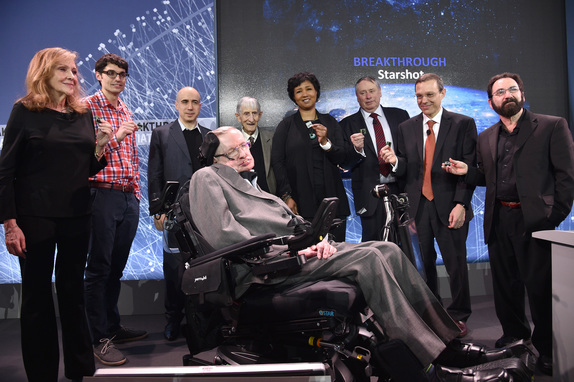
Stephen Hawking, Yuri Milner and Mark Zuckerberg are shooting for the stars [WATCH]
by Canadian Manufacturing.com Staff

The Breakthrough Starshot brings the Silicon Valley approach to space travel, capitalizing on exponential advances in technology

(L-R)Ann Druyan, Producer, Co-Founder and CEO of Cosmos Studios; Zac Manchester, Post-Doctoral Fellow, Harvard University; Yuri Milner, Breakthrough Prize and DST Global Founder; Stephen Hawking, CH, CBE, FRS, Dennis Stanton Avery and Sally Tsui Wong-Avery Director of Research, University of Cambridge; Freeman Dyson, Emeritus Professor, Princeton Institute for Advanced Study; Mae Jamison, Nasa Astronaut, Principal 100 Year Starship Foundation; Peter Worden, Chairman, Breaktrough Prize Foundation, Former NASA Director; Avi Loeb, Frank B. Baird, Jr. Professor of Science at Harvard University; and Philip Lubin, UC Santa Barbara Physics Professor. PHOTO: Bryan Bedder/Getty Images for Breakthrough Prize Foundation
The Breakthrough Starshot is a $100 million research and engineering program aiming to demonstrate proof of concept for light-propelled nanocrafts. These could fly at 20 per cent of light speed and capture images of possible planets and other scientific data in our nearest star system, Alpha Centauri, within about 20 years after they are launched.
The program will be led by Pete Worden, the former director of NASA AMES Research Center, and advised by a committee of world-class scientists and engineers. The board will consist of Stephen Hawking, Yuri Milner, and Mark Zuckerberg.
Breakthrough Starshot
The Alpha Centauri star system is 25 trillion miles (4.37 light years) away. With today’s fastest spacecraft, it would take about 30,000 years to get there. Breakthrough Starshot aims to establish whether a gram-scale nanocraft on a sail pushed by a light beam can fly a thousand times faster. It brings the Silicon Valley approach to space travel, capitalizing on exponential advances in certain areas of technology since the beginning of the 21st century.
Here’s a breakdown of how the mission will roll out:
Nanocrafts
Nanocrafts are gram-scale robotic spacecrafts comprising two main parts:
StarChip: Moore’s law has allowed a dramatic decrease in the size of microelectronic components. This creates the possibility of a gram-scale wafer, carrying cameras, photon thrusters, power supply, navigation and communication equipment, and constituting a fully functional space probe.
Lightsail: Advances in nanotechnology are producing increasingly thin and light-weight metamaterials, promising to enable the fabrication of meter-scale sails no more than a few hundred atoms thick and at gram-scale mass.
Light Beamer
The rising power and falling cost of lasers has lead to significant advances in light beaming technology. Meanwhile, phased arrays of lasers (the ‘light beamer’) could potentially be scaled up to the 100 gigawatt level. Breakthrough Starshot aims to bring economies of scale to the astronomical scale. The StarChip can be mass-produced at the cost of an iPhone and be sent on missions in large numbers to provide redundancy and coverage. The light beamer is modular and scalable. Once it is assembled and the technology matures, the cost of each launch is expected to fall to a few hundred thousand dollars.
Path to the stars
The research and engineering phase is expected to last a number of years. Following that, development of the ultimate mission to Alpha Centauri would require a budget comparable to the largest current scientific experiments, and would involve:
- Building a ground-based kilometer-scale light beamer at high altitude in dry conditions
- Generating and storing a few gigawatt hours of energy per launch
- Launching a ‘mothership’ carrying thousands of nanocrafts to a high-altitude orbit
- Taking advantage of adaptive optics technology in real time to compensate for atmospheric effects
- Focusing the light beam on the lightsail to accelerate individual nanocrafts to the target speed within minutes
- Accounting for interstellar dust collisions en route to the target
- Capturing images of a planet, and other scientific data, and transmitting them back to Earth using a compact on-board laser communications system
- Using the same light beamer that launched the nanocrafts to receive data from them over 4 years later.
These and other system requirements represent significant engineering challenges, and they can be reviewed in more detail online at www.breakthroughinitiatives.org. However, the key elements of the proposed system design are based on technology either already available or likely to be attainable in the near future under reasonable assumptions.
The proposed light propulsion system is on a scale significantly exceeding any currently operational analog. The very nature of the project calls for global co-operation and support.
Clearance for launches would be required from all the appropriate government and international organizations.
Open and collaborative environment
The Breakthrough Starshot initiative is:
- based entirely on research that is in the public domain.
- committed to publishing new results.
- dedicated to full transparency and open access.
- open to experts in all relevant fields, as well as the public, to contribute ideas through its online forum.